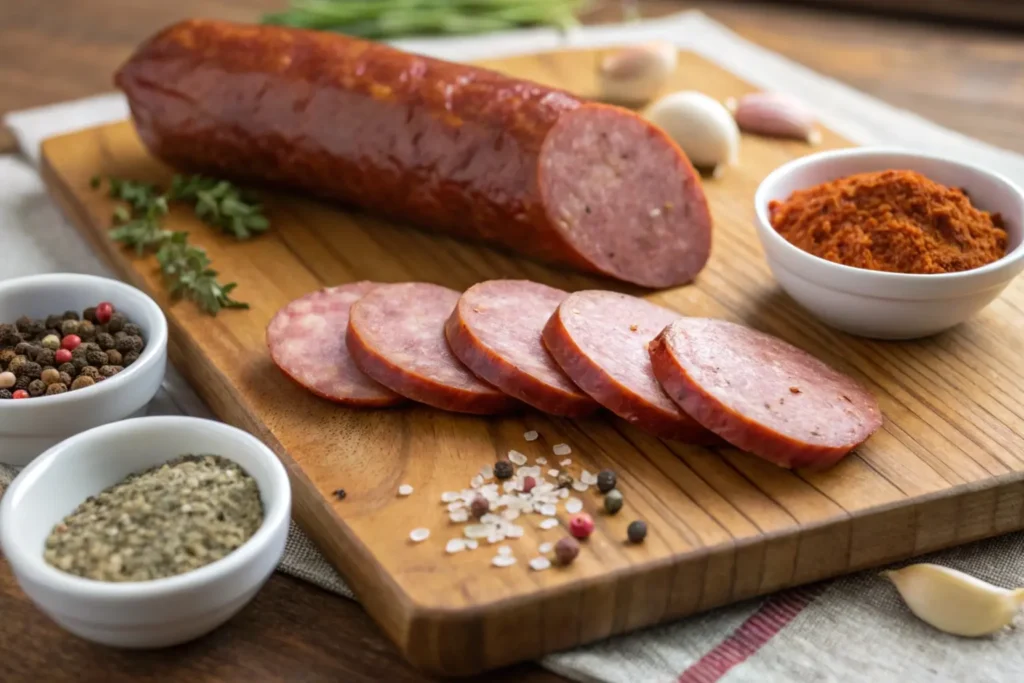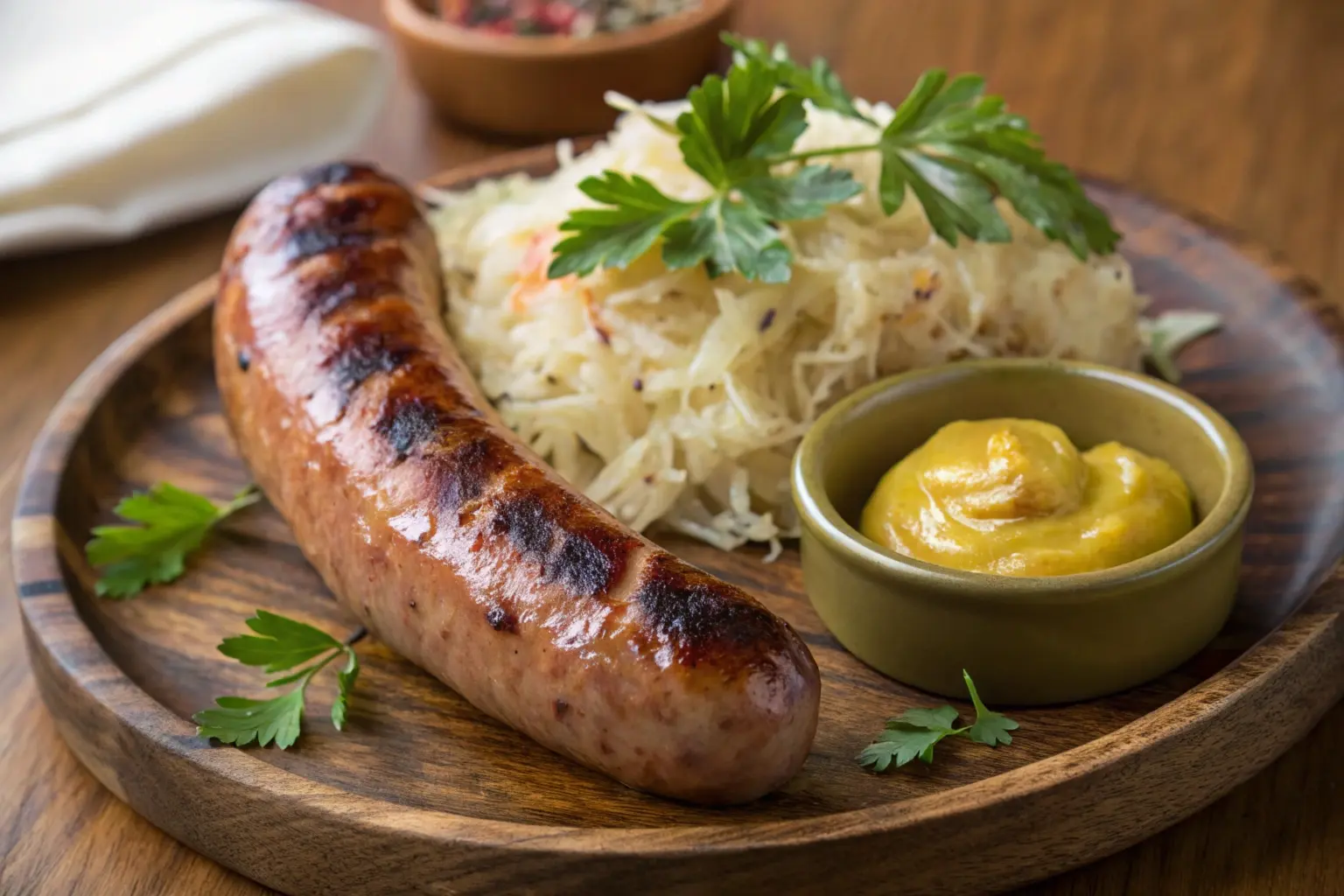Kielbasa, a beloved sausage originating from Poland, is known for its smoky, savory flavor and versatile uses in various dishes. But one question often stirs debates in kitchens: Should you peel kielbasa before cooking it? This article dives deep into the origins of kielbasa, the role of its casing, and whether peeling is necessary, helping you make an informed choice while elevating your cooking game.
Understanding Kielbasa
Kielbasa isn’t just any sausage; it’s a culinary icon with a rich heritage. To fully appreciate it, let’s explore what makes this sausage so special.
What Is Kielbasa?
Kielbasa, or Polish sausage, traces its roots to Poland, where it holds cultural and culinary significance. The word “kielbasa” simply means sausage in Polish, but it’s more than just a generic term. Traditional kielbasa boasts a distinctive U-shape, and it’s often made from pork, though beef or turkey variations are also popular.
With its unique blend of spices like garlic, marjoram, and pepper, kielbasa delivers a bold flavor that pairs well with a wide range of foods. Whether grilled, boiled, or fried, it’s a staple in comfort food recipes worldwide.
Ingredients and Casings
What makes kielbasa truly unique? Its ingredients and casing. Traditional kielbasa uses natural casings, usually made from pork intestines, which impart a signature snap and flavor. These casings are edible and enhance the sausage’s overall experience when cooked correctly.
On the other hand, some modern or mass-produced kielbasa may use synthetic casings. These aren’t always edible and might need to be peeled off before cooking. Knowing the type of casing is the first step in deciding whether to peel your kielbasa.
The Importance of Peeling Kielbasa
When faced with the question “Should I peel kielbasa before cooking?”, the answer often depends on personal preferences and the type of kielbasa you’re using. Let’s delve into the reasons for and against peeling this flavorful sausage.
Why Some People Peel Kielbasa

Peeling kielbasa is sometimes necessary, especially when the casing affects the overall experience of the dish. Here’s why some cooks choose to remove it:
- Textural Preferences
For some, the casing can feel too tough or chewy, especially if it’s synthetic. By peeling the casing, you get straight to the flavorful meat without any resistance. This can be crucial for recipes like stews or soups, where a smoother texture is preferred. - Synthetic Casings
Unlike natural casings, synthetic ones aren’t always edible. These casings are often used in pre-packaged or processed kielbasa. Removing them ensures that your dish isn’t compromised by an unpleasant bite. - Easier Integration into Recipes
Peeled kielbasa blends seamlessly into casseroles, pasta, or stir-fry dishes where casing texture might disrupt the dish’s balance.
When You Should Not Peel Kielbasa
On the flip side, there are cases where peeling is unnecessary—or even discouraged. Natural casings, for example, are designed to enhance the sausage’s flavor and cooking performance. Here’s when you can skip the peeling:
- Natural Casings and Their Benefits
Natural casings, typically made from pork intestines, are edible and add a delightful snap to the sausage when cooked. Peeling these casings removes this signature texture and could detract from the authentic kielbasa experience. - Cooking Methods That Retain Casing Integrity
If you’re grilling or frying kielbasa, keeping the casing on ensures that the sausage retains its juices and doesn’t fall apart. The casing acts as a protective barrier during high-heat cooking.
By understanding these factors, you can decide whether peeling kielbasa is worth the effort based on your recipe and personal taste.
Cooking Techniques for Kielbasa
The way you cook kielbasa can significantly influence whether you need to peel it. Different methods call for different approaches, and knowing the best techniques will help you make the most of this versatile sausage.
Boiling Kielbasa
Boiling is one of the simplest and most common ways to prepare kielbasa. Here’s how the method impacts the casing:
- How Boiling Affects Casings
During boiling, natural casings soften, making them easier to chew. This method is ideal for fresh kielbasa, as it cooks the sausage evenly without compromising its texture. - Tips for Achieving the Best Texture
To keep the casing intact, avoid overboiling. Instead, simmer the sausage gently for about 20 minutes, allowing the flavors to develop while the casing becomes tender.
Grilling and Pan-Frying Kielbasa
Grilling and pan-frying add a smoky, crispy edge to kielbasa. These methods enhance the sausage’s natural flavor but also put its casing to the test.
- Maintaining Casing During High-Heat Cooking
Natural casings can hold up well on the grill, creating a mouthwatering charred exterior. However, synthetic casings may split or shrink, making peeling essential before cooking. - Enhancing Flavor with Charred Casings
Keeping the casing intact while grilling gives you that signature snap with every bite. Plus, the casing locks in juices, preventing the meat from drying out.
Smoked and Pre-Cooked Kielbasa
Smoked kielbasa often comes pre-cooked, which changes how you approach its casing.
- Differences in Casing Requirements
For smoked kielbasa with natural casings, there’s no need to peel—it’s ready to eat or heat. However, pre-cooked kielbasa with synthetic casings might need peeling to avoid a plasticky texture. - Preparation Tips
Simply slice and heat smoked kielbasa to bring out its robust flavors. No peeling is needed unless the casing detracts from your preferred texture.
By mastering these cooking techniques, you can determine whether peeling kielbasa is the right choice for your recipe. This brings us closer to creating a perfect dish with this iconic sausage.
Tips for Maximizing Kielbasa Flavor
Kielbasa is more than just a sausage—it’s a versatile ingredient with bold flavors that can shine in a variety of dishes. But did you know there are ways to make its taste even better? From seasoning to pairing ideas, these tips will help you bring out the best in your kielbasa, whether you’re preparing a quick family dinner or an impressive feast.
Marinades and Seasonings
Marinating and seasoning your kielbasa isn’t just for enhancing its flavor—it’s a way to experiment with new taste profiles and create memorable dishes.
- Complementing the Smoky and Savory Profile
Kielbasa’s natural smoky flavor pairs beautifully with acidic marinades. For instance, try a mix of apple cider vinegar, honey, and a pinch of garlic powder. The acidity brightens the richness of the sausage while the sweetness balances the smoky undertones.If you’re cooking smoked kielbasa, a simple rub with olive oil, cracked black pepper, and rosemary adds an extra layer of aroma and taste. - Spicy and Bold Flavor Enhancements
If you’re looking for a spicier kick, season your kielbasa with cayenne pepper or paprika. Add a touch of cumin for a deeper, earthy note. For those who enjoy global flavors, marinades inspired by Korean BBQ (think soy sauce, brown sugar, sesame oil, and ginger) can give the kielbasa an exciting twist. - How to Properly Marinate Kielbasa
To ensure your marinade works effectively, score the surface of the kielbasa lightly with a knife before soaking it. This helps the flavors penetrate deeper into the sausage. Marinate in the refrigerator for at least 30 minutes, but for richer flavor, let it sit overnight.
Pairing Kielbasa with Other Foods
What you pair with kielbasa can elevate your dish from simple to sensational. The key is to complement its robust flavor while creating a balanced meal.
- Classic Pairings Like Sauerkraut and Potatoes
One of the most popular pairings is sauerkraut, a tangy and slightly sour fermented cabbage dish. The acidity of the sauerkraut cuts through the richness of kielbasa, creating a well-rounded bite. Adding boiled or roasted potatoes makes the meal hearty and satisfying. - Hearty Grain and Vegetable Bowls
For a modern twist, serve kielbasa sliced over a bed of quinoa or wild rice, accompanied by roasted Brussels sprouts, carrots, or sweet potatoes. The smokiness of the sausage complements the nutty grains and caramelized vegetables. - Creative Dishes Featuring Kielbasa
Kielbasa’s versatility makes it a perfect addition to casseroles, pasta, and soups. For example, you can dice and sauté kielbasa with onions and garlic, then toss it into macaroni and cheese for a smoky, savory upgrade. Alternatively, add it to a hearty lentil or bean soup for extra protein and flavor.
Cooking Kielbasa to Boost Flavor
Cooking methods also play a big role in enhancing the taste of kielbasa. Each technique has its own unique way of bringing out the sausage’s best qualities.
- Grilling and Smoking
When you grill kielbasa, the high heat caramelizes its natural sugars, creating a crispy, flavorful exterior. Smoking adds another layer of depth, especially if you use wood chips like hickory or applewood. These methods are perfect for retaining the sausage’s casing, which adds a satisfying snap. - Sautéing and Pan-Frying
A quick sauté with a little butter or olive oil can amplify kielbasa’s flavor. For an added punch, throw in sliced onions, bell peppers, or mushrooms. The vegetables will soak up the sausage’s juices, making the whole dish rich and flavorful. - Boiling for Soups and Stews
When using kielbasa in soups or stews, boil it gently to keep its natural juices intact. You can peel it beforehand if the casing doesn’t suit your dish, but for most recipes, leaving it on provides added flavor.
Should I Peel Kielbasa Before Cooking?
While enhancing the flavor of kielbasa, one question often arises: Should I peel kielbasa before cooking? If you’re marinating or using the sausage in soups, peeling synthetic casings might help flavors penetrate better. However, natural casings not only add texture but also hold in juices, especially when grilling or frying.
Incorporating these tips into your cooking routine ensures that every bite of kielbasa is bursting with flavor. Experiment with seasonings, try new pairings, and master cooking techniques to elevate this humble sausage into a culinary highlight.
Frequently Asked Questions
When it comes to cooking kielbasa, there are always a few lingering questions. Let’s address some of the most common ones to help you perfect your next dish.
Do You Have to Peel Kielbasa?
The question “Should I peel kielbasa before cooking?” depends on the casing. For natural casings, peeling isn’t necessary; they’re meant to be eaten. However, synthetic casings might need to be removed, especially if they’re tough or inedible.
What Is the Best Way to Cook Kielbasa Without Peeling?
If you prefer to keep the casing intact, grilling or boiling are excellent options. These methods soften natural casings while locking in the sausage’s juicy flavors. Avoid overcooking, as this can toughen the casing.
How Do I Know If the Casing Is Edible?
Natural casings are typically thin and pliable, while synthetic ones may feel thick or plasticky. Always check the packaging for guidance, especially if you’re unsure. A quick test: synthetic casings often resist when pierced with a fork.

